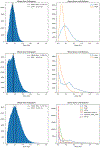A stochastic model of blood flow to calculate blood dose during radiotherapy
- PMID: 37827171
- PMCID: PMC10695181
- DOI: 10.1088/1361-6560/ad02d6
A stochastic model of blood flow to calculate blood dose during radiotherapy
Abstract
Purpose. Lymphopenia is a common side effect in patients treated with radiotherapy, potentially caused by direct cell killing of circulating lymphocytes in the blood. To investigate this hypothesis, a method to assess dose to circulating lymphocytes is needed.Methods. A stochastic model to simulate systemic blood flow in the human body was developed based on a previously designed compartment model. Blood dose was obtained by superimposing the spatiotemporal distribution of blood particles with a time-varying dose rate field, and used as a surrogate for dose to circulating lymphocytes. We discuss relevant theory on compartmental modeling and how to combine it with models of explicit organ vasculature.Results. A general workflow was established which can be used for any anatomical site. Stochastic compartments can be replaced by explicit models of organ vasculatures for improved spatial resolution, and tumor compartments can be dynamically assigned. Generating a patient-specific blood flow distribution takes about one minute, fast enough to investigate the effect of varying treatment parameters such as the dose rate. Furthermore, the anatomical structures contributing most to the overall blood dose can be identified, which could potentially be used for lymphocyte-sparing treatment planning.Conclusion. The ability to report the blood dose distribution during radiotherapy is imperative to test and act upon the current paradigm that radiation-induced lymphopenia is caused by direct cell killing of lymphocytes in the blood. We have built a general model that can do so for various treatment sites. The presented framework is publicly available athttp://github.com/mghro/hedos.
Keywords: Weibull distribution; blood dose; blood flow; organ vasculature; stochastic compartment model; tranfer function.
© 2023 Institute of Physics and Engineering in Medicine.
Figures





References
-
- McCullum L, Shin J, Xing S, et al. Predicting Severity of Radiation Induced Lymphopenia in Individual Proton Therapy Patients for Varying Dose Rate and Fractionation Using Dynamic 4-Dimensional Blood Flow Simulations. Int J Radiat Oncol. 2023;Epub ahead. doi:10.1016/j.ijrobp.2023.01.054 - DOI - PMC - PubMed
MeSH terms
Grants and funding
LinkOut - more resources
Full Text Sources
Other Literature Sources
Medical
